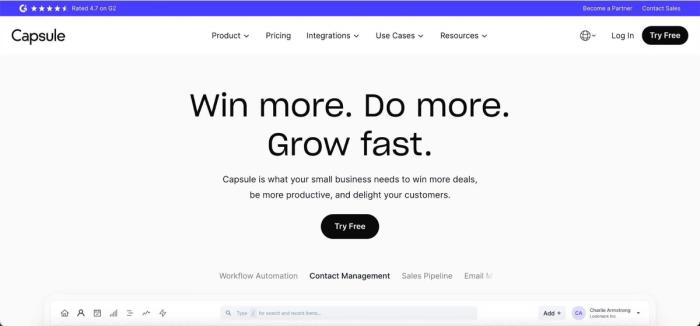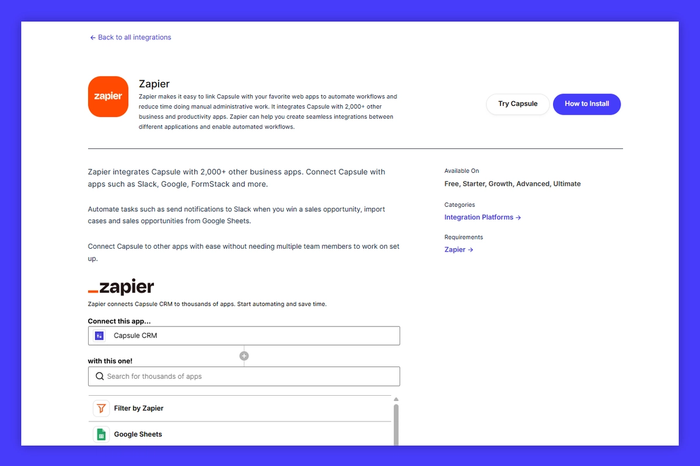Most small businesses start with a CRM, and for good reason. It helps you stay on top of leads and client history. As you grow, though, you’ll likely add more tools: email platforms, analytics, ads, maybe even a mobile app? That’s when customer data starts to scatter.
While a CRM helps you manage relationships, a CDP pulls behavioral data from all your digital channels into one place. It’s powerful, but often more than small teams need.
This guide will help you understand the difference, see where each tool fits, and help you decide if you’re fine with one or ready for both.
CRM: Track conversations and deals
A CRM is your command center for managing customer interactions. It keeps your team aligned on who said what, when, and what’s next – across sales, service, and support.
Most small businesses start here. Why? Because a CRM:
- Stores contact details, notes, and communication history
- Helps teams follow up without relying on memory
- Keeps deals moving with clear timelines and tasks
If someone fills out your form, schedules a call, and buys a week later, a CRM connects those dots. You’re never starting from scratch.
Best for: Sales reps, account managers, support teams
Main value: Keeps customer-facing work consistent, personal, and organized
Typical setup: Manual or semi-automated data entry (calls, emails, forms, etc.)

CDP: Centralize behavioral data across channels
A CDP collects and connects customer behavior from every digital touchpoint — your website, email campaigns, mobile app, online store, and ads — and builds a unified profile of each person.
It uses identity resolution to match anonymous activity with known users. So, if someone clicks an ad on mobile, signs up by email, and buys in-store, the CDP knows it's the same person.
That kind of insight is gold for:
- Segmenting customers by behavior
- Powering personalized marketing
- Analyzing cross-channel engagement
Best for: Marketing teams, data analysts, digital strategists
Main value: Deeper visibility into how customers move, click, and convert
Typical setup: Automated data collection from platforms like Shopify, Mailchimp, and Meta Ads
CDPs are powerful, but they come with more complexity. Unless you're maanging multiple channels and want to act on behavioral trends at scale, a CDP might be overkill.
CRM vs CDP: What to choose?
If you're comparing CRM and CDP, it's easy to assume the latter is more advanced — and therefore better. But that’s not always the case.
These tools serve different needs. And in many cases, starting smaller gets you further.
A CRM helps you organize relationships and sales activity — fast. A CDP pulls together customer behavior across your digital tools — powerful, but heavier to implement.
So which one makes sense for where you are now? Let’s start with the one most small businesses benefit from first: the CRM.
Start with CRM: What it solves & who it’s for
If you're tracking leads in spreadsheets, toggling between inboxes, and relying on memory to follow up, you’re not alone. That’s exactly where most small businesses begin. And it’s exactly why CRM is often the first tool they reach for.
Common triggers that say ‘It’s time for a CRM’:
- You forgot to follow up with a warm lead (and lost the deal)
- Two people on your team emailed the same client differently
- You can’t remember where a customer is in the sales process
- You’re onboarding new team members, and knowledge is scattered
In other words, you’ve outgrown your inbox and need to rely on more than just your memory.
Why small teams start here
CRM systems are designed to support real, human interactions — the conversations and next steps that build relationships and close deals. They’re quick to set up, easy to maintain, and they return value almost immediately. Research also shows an average CRM ROI of 211%, which can potentially surge to over 600% when software utilization and user adoption are high.
That’s why CRMs (like Capsule) are often one of the first software investments small businesses make: they can help you stop losing time and deals.

When a CDP becomes the right move
At some point, your CRM starts feeling like it’s only showing part of the picture.
You’re running email campaigns, placing ads, maybe even working across a website, app, and newsletter — but your data’s split between tools, and you can’t see how it all connects. That’s when a Customer Data Platform (CDP) can help.
CDP connects the dots your CRM can’t
A CDP pulls customer behavior from across your digital channels — clicks, opens, visits, purchases — and builds unified profiles based on identity resolution. So the person who clicks your ad, signs up via email, and buys in-store? You’ll know it’s the same person.
This unlocks things like:
- Smarter audience segments (e.g. people who browsed twice but haven’t purchased)
- More personalized campaigns
- Better insight into how users move from interest to action
CDPs work best when:
- You rely on multiple digital tools that don’t talk to each other
- You want to segment based on behavior, not just contact fields
- You’re investing in personalization or scaling your marketing
That said, CDPs aren’t for every team – or, at least, not right away. They’re more complex to set up and need thoughtful data flows. If you’re still building your core sales and marketing systems, jumping into CDP territory too early can slow you down.
But if you’re already managing campaigns across channels and feel blind to what’s actually working, a CDP can bring the clarity you’re missing.
💡 Most small teams don’t need a CDP — a well-used CRM goes a long way.
CRM or CDP? Quick fit checklist
Not sure which system fits your current needs? Use this checklist to help you decide where you are — and what will actually help.
✅ A CRM is the right fit if:
- You manage customer relationships through calls, emails, or meetings
- Your leads and sales notes live in spreadsheets or inboxes
- You need better visibility into your sales pipeline and follow-ups
- Your marketing is straightforward and doesn’t rely on complex targeting
- You want to improve customer experience without a big tech lift
- Your tools are mostly offline or lightly digital (like forms, email platforms)
✅ A CDP might make sense if:
- You’re running marketing campaigns across 3+ digital channels (email, ads, web, app)
- Your customer data lives in multiple platforms that don’t sync
- You want to build segments based on behavior (not just job title or industry)
- You’re investing in personalization and want a full view of each customer’s journey
- You need to connect anonymous activity (like browsing) with known users
- You’ve hit limits in what your CRM and email tools can show you
Using both: how CRM and CDP can work together
CRM and CDP aren’t rivals — they’re built for different jobs. And as your business grows, there’s a good chance you’ll end up using both.
CRM handles the who
Names, deals, conversations, follow-ups – the CRM is your relationship tracker. It’s where your team sees what’s been said, what’s next, and who’s responsible.
CDP tracks the how
Clicks, visits, app usage, email activity — the CDP builds the behavioral picture. It shows how someone engages across channels, long before (and after) they talk to sales.
Together, these tools give you both sides of the story:
- CDP segments your audience by what they do
- CRM helps your team follow up with the right message at the right time
- CDP surfaces trends — CRM acts on them
- CDP sees the journey — CRM personalizes the touchpoints
If you're using both, keep it simple:
1. Make sure your tools can talk to each other
Look for built-in integrations, or use tools like Zapier to sync them up.

2. Standardize your customer data
Use consistent fields (especially email addresses) across systems. Clean up duplicates before importing anything new.
3. Align your teams
Encourage marketing and sales to share insights. If your CDP shows what pages people visit before converting, your CRM team can tailor their outreach.
4. Start with one connection
You don’t need to wire up everything at once. Start by linking your CRM to your email platform, or your CDP to your website traffic, and build from there.
How Family Wise moved from notes to a scalable CRM
Family Wise started as a solo venture and quickly grew into a 40-person team. But their way of tracking client activity didn’t grow with them. Spreadsheets and inboxes made it hard to stay organized, and easy to miss follow-ups.
Switching to Capsule gave them a structured way to manage client relationships across the business.
Today, the team uses Capsule to:
- Keep project and client info consistent across departments
- Schedule follow-ups automatically
- Respond faster with integrated call records and notes
- Train new team members without relying on tribal knowledge
They didn’t need to invest in a CDP. Capsule’s CRM gave them everything they needed to stay organized, responsive, and ready to grow.
It can do the same for you — start your free trial today.
Get more from your customer data — without overcomplicating it
For the majority of small businesses, a CRM is not just a starting point — it’s all you need. It helps you keep up with customers and run day-to-day operations.
CDPs have their place, especially for teams working across lots of platforms. But most growing businesses won’t need one for a long time, if ever.
Try Capsule free and see how much simpler your workflow can be.
Frequently Asked Questions
A CRM helps you manage relationships, track leads, log conversations, and follow up.
A CDP brings together customer data from multiple platforms to build unified profiles and support personalized marketing.
Most small businesses get what they need from a CRM. A CDP becomes useful when you're working across several channels and need to link behavioral data for better targeting.
Some CRMs capture marketing data, but they’re built for managing interactions. A CDP collects and connects data from many sources. You can use both together for a fuller view.
Not anymore. Lighter-weight CDPs are now available for smaller teams. But unless you're dealing with lots of disconnected tools, you probably don’t need one yet.




